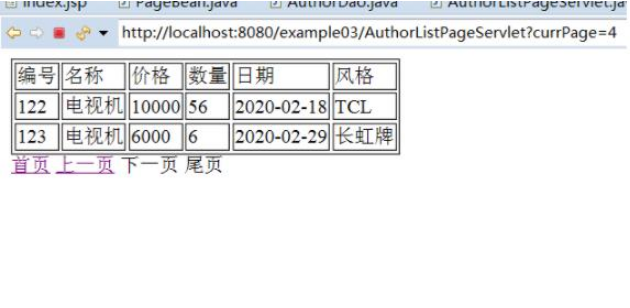How to use jsp+mysql to implement paging query on web pages
1. The core sql statement to implement paging query
(1) The sql statement for querying the total number of records in the database:
select count(*) from +(表名);
(2) The sql statement for each query of the number of records:
Where: 0 is the search index, 2 is the number of items searched each time.
select * from 表名 limit 0,2;
2. Code Implementation
In the previous article, I have introduced the DBconnection class and the Author object class. The former is used to obtain the database connection, and the latter is used to represent the author object. Click on the link to view the code for these two classes. Click the link to view the DBconnection class and Author object class
(1) Login page: index.jsp.
<%@ page language="java" contentType="text/html; charset=utf-8"
pageEncoding="utf-8"%>
<!DOCTYPE html>
<html>
<head>
<meta charset="utf-8">
<title>Insert title here</title>
</head>
<body>
<a href="AuthorListPageServlet">用户列表分页查询</a>
</body>
</html>(2) Display page: userlistpage.jsp.
<%@ page language="java" contentType="text/html; charset=utf-8"
pageEncoding="utf-8"%>
<%@ taglib prefix="c" uri="http://java.sun.com/jsp/jstl/core" %>
<!DOCTYPE html>
<html>
<head>
<meta charset="utf-8">
<title>查询页面</title>
</head>
<body>
<table border="1">
<tr>
<td>编号</td>
<td>名称</td>
<td>价格</td>
<td>数量</td>
<td>日期</td>
<td>风格</td>
</tr>
<c:forEach items="${pageBean.list}" var="author">
<tr>
<td>${author.id}</td>
<td>${author.name }</td>
<td>${author.price }</td>
<td>${author.num }</td>
<td>${author.dates}</td>
<td>${author.style}</td>
</tr>
</c:forEach>
</table>
<c:if test="${ pageBean.record>0}">
<div>
<c:if test="${pageBean.currentPage <= 1}">
<span>首页</span>
<span>上一页</span>
<a href ="AuthorListPageServlet?currPage=${pageBean.currentPage + 1 }">下一页</a>
<a href ="AuthorListPageServlet?currPage=${pageBean.totalPage }">尾页</a>
</c:if>
<c:if test="${pageBean.currentPage > 1 && pageBean.currentPage < pageBean.totalPage }">
<a href ="AuthorListPageServlet?currPage=1">首页</a>
<a href ="AuthorListPageServlet?currPage=${pageBean.currentPage - 1 }">上一页</a>
<a href ="AuthorListPageServlet?currPage=${pageBean.currentPage + 1 }">下一页</a>
<a href ="AuthorListPageServlet?currPage=${pageBean.totalPage }">尾页</a>
</c:if>
<c:if test="${ pageBean.currentPage >= pageBean.totalPage}">
<a href ="AuthorListPageServlet?currPage=1">首页</a>
<a href ="AuthorListPageServlet?currPage=${pageBean.currentPage - 1 }">上一页</a>
<span>下一页</span>
<span>尾页</span>
</c:if>
</div>
</c:if>
</body>
</html>(3) Function implementation: AuthorDao.java.
package com.dao;
import java.sql.Connection;
import java.sql.PreparedStatement;
import java.sql.ResultSet;
import java.sql.SQLException;
import java.util.ArrayList;
import java.util.List;
import com.entity.Author;
public class AuthorDao {
public Author check(String username ,int password ) {
Author obj = null ;
try {
DBConnection db = new DBConnection();
//获取数据库连接
Connection conn = db.getConn();
String sql="select *from furnitures where name = ? and id = ?";
PreparedStatement ps=conn.prepareStatement(sql);
//设置用户名和密码作为参数放入sql语句
ps.setString(1,username);
ps.setInt(2,password);
//执行查询语句
ResultSet rs = ps.executeQuery();
//用户名和密码正确,查到数据 欧式风格 茶几
if(rs.next()) {
obj = new Author();
obj.setId(rs.getInt(1));
obj.setName(rs.getString(2));
obj.setPrice(rs.getInt(3));
obj.setNum(rs.getInt(4));
obj.setDates(rs.getString(5));
obj.setStyle(rs.getString(6));
}
} catch (SQLException e) {
// TODO Auto-generated catch block
e.printStackTrace();
}
return obj;
}
/**
* 用户列表信息查询
* @return
*/
public List<Author> queryAuthorList(){
Author obj = null ;
List<Author> list = new ArrayList<Author>();
try {
DBConnection db = new DBConnection();
//获取数据库连接
Connection conn = db.getConn();
String sql="select *from furnitures";
PreparedStatement ps=conn.prepareStatement(sql);
//执行查询语句
ResultSet rs = ps.executeQuery();
//用户名和密码正确,查到数据 欧式风格 茶几
//循环遍历获取用户信息
while(rs.next()) {
obj = new Author();
obj.setId(rs.getInt(1));
obj.setName(rs.getString(2));
obj.setPrice(rs.getInt(3));
obj.setNum(rs.getInt(4));
obj.setDates(rs.getString(5));
obj.setStyle(rs.getString(6));
//将对象加入list里边
list.add(obj);
}
} catch (SQLException e) {
// TODO Auto-generated catch block
e.printStackTrace();
}
return list;
}
/**
* 查询用户表总记录数
* @return
*/
public int queryUserListCount() {
DBConnection db;
try {
db = new DBConnection();
Connection conn = db.getConn();
String sql = "select count(*) from furnitures";
PreparedStatement ps = conn.prepareStatement(sql);
ResultSet rs = ps.executeQuery();
if(rs.next()) {
return rs.getInt(1);
}
} catch (SQLException e) {
// TODO Auto-generated catch block
e.printStackTrace();
}
return 0;
}
/**
* 查询用户分页数据
* @param pageIndex数据起始索引
* @param pageSize每页显示条数
* @return
*/
public List<Author>queryUserListPage(int pageIndex,int pageSize){
Author obj = null;
List<Author> list = new ArrayList<Author>();
try {
Connection conn = new DBConnection().getConn();
String sql = "select * from furnitures limit ?,?;";
PreparedStatement ps = conn.prepareStatement(sql);
ps.setObject(1, pageIndex);
ps.setObject(2,pageSize);
ResultSet rs = ps.executeQuery();
//遍历结果集获取用户列表数据
while(rs.next()) {
obj = new Author();
obj.setId(rs.getInt(1));
obj.setName(rs.getString(2));
obj.setPrice(rs.getInt(3));
obj.setNum(rs.getInt(4));
obj.setDates(rs.getString(5));
obj.setStyle(rs.getString(6));
list.add(obj);
}
} catch (SQLException e) {
// TODO Auto-generated catch block
e.printStackTrace();
}
return list;
}
/**
* 用户新增
* @param obj
*/
public void add(Author obj) {
try {
DBConnection db = new DBConnection();
//获取数据库连接
Connection conn = db.getConn();
String sql="insert into furnitures values(id,?,?,?,?,?)";
PreparedStatement ps=conn.prepareStatement(sql);
ps.setObject(1, obj.getName());
ps.setObject(2, obj.getPrice());
ps.setObject(3, obj.getNum());
ps.setObject(4,obj.getDates());
ps.setObject(5, obj.getStyle());
//执行sql语句
ps.execute();
} catch (SQLException e) {
// TODO Auto-generated catch block
e.printStackTrace();
}
}
//删除用户
public void del(int id) {
try {
DBConnection db = new DBConnection();
//获取数据库连接
Connection conn = db.getConn();
String sql="delete from furnitures where id = ?";
PreparedStatement ps=conn.prepareStatement(sql);
ps.setObject(1, id);
//执行sql语句
ps.execute();
} catch (SQLException e) {
// TODO Auto-generated catch block
e.printStackTrace();
}
}
}(4) Interaction layer: AuthorListPageServlet.java.
package com.servlet;
import java.io.IOException;
import java.util.List;
import javax.servlet.ServletException;
import javax.servlet.annotation.WebServlet;
import javax.servlet.http.HttpServlet;
import javax.servlet.http.HttpServletRequest;
import javax.servlet.http.HttpServletResponse;
import com.dao.AuthorDao;
import com.entity.Author;
import com.util.PageBean;
/**
* Servlet implementation class AuthorListPageServlet
*/
@WebServlet("/AuthorListPageServlet")
public class AuthorListPageServlet extends HttpServlet {
private static final long serialVersionUID = 1L;
/**
* @see HttpServlet#HttpServlet()
*/
public AuthorListPageServlet() {
super();
// TODO Auto-generated constructor stub
}
/**
* @see HttpServlet#doGet(HttpServletRequest request, HttpServletResponse response)
*/
protected void doGet(HttpServletRequest request, HttpServletResponse response) throws ServletException, IOException {
// TODO Auto-generated method stub
int pageSize = 2;
AuthorDao ad = new AuthorDao();
//总记录数
int record = ad.queryUserListCount();
//接收页面传入的页码
String strPage = request.getParameter("currPage");
int currPage = 1;//默认第一页
if(strPage != null) {
currPage = Integer.parseInt(strPage);
}
PageBean<Author> pb = new PageBean<Author>(currPage,pageSize,record);
//查询某一页的结果集
List<Author> list = ad.queryUserListPage(pb.getPageIndex(), pageSize);
pb.setList(list);
request.setAttribute("pageBean", pb);
request.getRequestDispatcher("userlistpage.jsp").forward(request, response);
}
/**
* @see HttpServlet#doPost(HttpServletRequest request, HttpServletResponse response)
*/
protected void doPost(HttpServletRequest request, HttpServletResponse response) throws ServletException, IOException {
// TODO Auto-generated method stub
doGet(request, response);
}
}(5) Tool class: PageBean.java. The function is: obtain the result set.
package com.util;
import java.util.List;
public class PageBean<T>{
private int currentPage;//当前页码
private int pageIndex;//数据起始索引
private int pageSize;//每页条数
private int record;//总记录数
private int totalPage;//总页数
private List<T>list;//每页显示的结果集
/**
* 构造方法初始化pageIndex和totalPage
* @param currentPage
* @param pageIndex
* @param pageSize
*/
public PageBean(int currentPage,int pageSize,int record) {
this.currentPage = currentPage;
this.pageSize = pageSize;
this.record = record;
//总页数
if(record % pageSize == 0) {
//整除,没有多余的页
this.totalPage = record / pageSize;
}
else {
//有多余的数据,在增加一页
this.totalPage = record / pageSize + 1;
}
//计算数据起始索引pageIndex
if(currentPage < 1) {
this.currentPage = 1;
}
else if(currentPage > this.totalPage) {
this.currentPage = this.totalPage;
}
this.pageIndex = (this.currentPage -1)*this.pageSize;
}
public int getCurrentPage() {
return currentPage;
}
public void setCurrentPage(int currentPage) {
this.currentPage = currentPage;
}
public int getPageIndex() {
return pageIndex;
}
public void setPageIndex(int pageIndex) {
this.pageIndex = pageIndex;
}
public int getPageSize() {
return pageSize;
}
public void setPageSize(int pageSize) {
this.pageSize = pageSize;
}
public int getRecord() {
return record;
}
public void setRecord(int record) {
this.record = record;
}
public int getTotalPage() {
return totalPage;
}
public void setTotalPage(int totalPage) {
this.totalPage = totalPage;
}
public List<T> getList() {
return list;
}
public void setList(List<T> list) {
this.list = list;
}
}3. Running results
(1) Home page:



The above is the detailed content of How to use jsp+mysql to implement paging query on web pages. For more information, please follow other related articles on the PHP Chinese website!

Hot AI Tools

Undresser.AI Undress
AI-powered app for creating realistic nude photos

AI Clothes Remover
Online AI tool for removing clothes from photos.

Undress AI Tool
Undress images for free

Clothoff.io
AI clothes remover

AI Hentai Generator
Generate AI Hentai for free.

Hot Article

Hot Tools

Notepad++7.3.1
Easy-to-use and free code editor

SublimeText3 Chinese version
Chinese version, very easy to use

Zend Studio 13.0.1
Powerful PHP integrated development environment

Dreamweaver CS6
Visual web development tools

SublimeText3 Mac version
God-level code editing software (SublimeText3)

Hot Topics
 1386
1386
 52
52
 MySQL: Simple Concepts for Easy Learning
Apr 10, 2025 am 09:29 AM
MySQL: Simple Concepts for Easy Learning
Apr 10, 2025 am 09:29 AM
MySQL is an open source relational database management system. 1) Create database and tables: Use the CREATEDATABASE and CREATETABLE commands. 2) Basic operations: INSERT, UPDATE, DELETE and SELECT. 3) Advanced operations: JOIN, subquery and transaction processing. 4) Debugging skills: Check syntax, data type and permissions. 5) Optimization suggestions: Use indexes, avoid SELECT* and use transactions.
 How to open phpmyadmin
Apr 10, 2025 pm 10:51 PM
How to open phpmyadmin
Apr 10, 2025 pm 10:51 PM
You can open phpMyAdmin through the following steps: 1. Log in to the website control panel; 2. Find and click the phpMyAdmin icon; 3. Enter MySQL credentials; 4. Click "Login".
 MySQL: An Introduction to the World's Most Popular Database
Apr 12, 2025 am 12:18 AM
MySQL: An Introduction to the World's Most Popular Database
Apr 12, 2025 am 12:18 AM
MySQL is an open source relational database management system, mainly used to store and retrieve data quickly and reliably. Its working principle includes client requests, query resolution, execution of queries and return results. Examples of usage include creating tables, inserting and querying data, and advanced features such as JOIN operations. Common errors involve SQL syntax, data types, and permissions, and optimization suggestions include the use of indexes, optimized queries, and partitioning of tables.
 Why Use MySQL? Benefits and Advantages
Apr 12, 2025 am 12:17 AM
Why Use MySQL? Benefits and Advantages
Apr 12, 2025 am 12:17 AM
MySQL is chosen for its performance, reliability, ease of use, and community support. 1.MySQL provides efficient data storage and retrieval functions, supporting multiple data types and advanced query operations. 2. Adopt client-server architecture and multiple storage engines to support transaction and query optimization. 3. Easy to use, supports a variety of operating systems and programming languages. 4. Have strong community support and provide rich resources and solutions.
 How to use single threaded redis
Apr 10, 2025 pm 07:12 PM
How to use single threaded redis
Apr 10, 2025 pm 07:12 PM
Redis uses a single threaded architecture to provide high performance, simplicity, and consistency. It utilizes I/O multiplexing, event loops, non-blocking I/O, and shared memory to improve concurrency, but with limitations of concurrency limitations, single point of failure, and unsuitable for write-intensive workloads.
 MySQL and SQL: Essential Skills for Developers
Apr 10, 2025 am 09:30 AM
MySQL and SQL: Essential Skills for Developers
Apr 10, 2025 am 09:30 AM
MySQL and SQL are essential skills for developers. 1.MySQL is an open source relational database management system, and SQL is the standard language used to manage and operate databases. 2.MySQL supports multiple storage engines through efficient data storage and retrieval functions, and SQL completes complex data operations through simple statements. 3. Examples of usage include basic queries and advanced queries, such as filtering and sorting by condition. 4. Common errors include syntax errors and performance issues, which can be optimized by checking SQL statements and using EXPLAIN commands. 5. Performance optimization techniques include using indexes, avoiding full table scanning, optimizing JOIN operations and improving code readability.
 MySQL's Place: Databases and Programming
Apr 13, 2025 am 12:18 AM
MySQL's Place: Databases and Programming
Apr 13, 2025 am 12:18 AM
MySQL's position in databases and programming is very important. It is an open source relational database management system that is widely used in various application scenarios. 1) MySQL provides efficient data storage, organization and retrieval functions, supporting Web, mobile and enterprise-level systems. 2) It uses a client-server architecture, supports multiple storage engines and index optimization. 3) Basic usages include creating tables and inserting data, and advanced usages involve multi-table JOINs and complex queries. 4) Frequently asked questions such as SQL syntax errors and performance issues can be debugged through the EXPLAIN command and slow query log. 5) Performance optimization methods include rational use of indexes, optimized query and use of caches. Best practices include using transactions and PreparedStatemen
 Monitor Redis Droplet with Redis Exporter Service
Apr 10, 2025 pm 01:36 PM
Monitor Redis Droplet with Redis Exporter Service
Apr 10, 2025 pm 01:36 PM
Effective monitoring of Redis databases is critical to maintaining optimal performance, identifying potential bottlenecks, and ensuring overall system reliability. Redis Exporter Service is a powerful utility designed to monitor Redis databases using Prometheus. This tutorial will guide you through the complete setup and configuration of Redis Exporter Service, ensuring you seamlessly build monitoring solutions. By studying this tutorial, you will achieve fully operational monitoring settings





